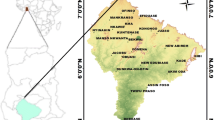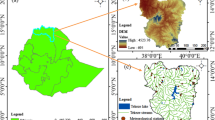Abstract
Purpose
Understanding the spatial dynamics of soil loss (SL) and sediment yield (SY) from ungauged watersheds would have a profound importance to devise informed land resource and flood management strategies. Such information particularly substantial for rivers like Koshi, that typically causing severe land degradation and frequent devastating flood risks to large number of inhabitants in the basin. This study aimed to estimate the spatial heterogeneity of mean annual SL and SY in Triyuga river watershed (TRW) and delivers into Sapta-Koshi.
Materials and methods
The Revised Universal Soil Loss Equation (RUSLE) and Slope-based Sediment Delivery Ratio (SDR) models along with Geographic Information System (GIS) and remote sensing techniques were applied.
Results and discussion
The mean SL and SY were found to be 31 and 3.04 t/ha/year, respectively. Accordingly, an estimated 2.2 × 105 tons of sediment was delivered into the Sapta-Koshi river annually. In this watershed, nearly 62% of the area is under the category of high to very severe soil loss rate (SLR), which together accounted for 96% of the total SL in the TRW. The critical SLR was mostly distributed along the northern escarpment of the study area. Most of the slo** areas in the northwestern and some patches of the northeastern tip regions that accompany with slope class > 26.8% are particularly vulnerable to severe SL and SY in the TRW. In this regard, the RUSLE LS factor has played the significant (r = 0.88, p < 0.001) impact over other RUSLE factors.
Conclusion
High elevation and steep slope class in the northwestern and northeastern parts of the watershed are the major SL and SY hotspot sites that require special attention and priority for conservation interventions in the TRW.








Similar content being viewed by others
References
Abdo H, Salloum J (2017) Map** the soil loss in Marqya basin: Syria using RUSLE model in GIS and RS techniques. Environ Earth Sci. https://doi.org/10.1007/s12665-017-6424-0
Asmamaw LB, Mohammed AA (2019) Identification of soil erosion hotspot areas for sustainable land management in the Gerado catchment, North-eastern Ethiopia. Remote Sens Appl Soc Environ 13:306–317
Ban JK, Yu I, Jeong S (2016) Estimation of soil erosion using RUSLE model and GIS techniques for conservation planning from Kulekhani reservoir catchment. Nepal J Korean Soc Hazard Mitig 16:323–330
Batista PVG, Silva MLN, Silva BPC et al (2017) Modelling spatially distributed soil losses and sediment yield in the upper Grande river basin - Brazil. Catena 157:139–150
Belayneh Y, Ru G, Guadie A et al (2018) Forest cover change and its driving forces in Fagita Lekoma District, Ethiopia. J for Res 31:1567–1582
Beskow S, Mello CR, Norton LD et al (2009) Soil erosion prediction in the Grande river basin, Brazil using distributed modeling. Catena 79:49–59
Boakye E, Anyemedu FOK, Donkor EA, Quaye-Ballard JA (2020) Spatial distribution of soil erosion and sediment yield in the Pra river basin. SN Appl Sci 2:320. https://doi.org/10.1007/s42452-020-2129-1
Chalise D, Kumar L (2020) Land use change affects water erosion in the Nepal Himalayas. PLoS One. https://doi.org/10.1371/journal.pone.0231692
Chalise D, Kumar L, Shriwastav CP, Lamichhane S (2018) Spatial assessment of soil erosion in a hilly watershed of Western Nepal. Environ Earth Sci. https://doi.org/10.1007/s12665-018-7842-3
Chinnasamy P, Sood A (2020) Estimation of sediment load for Himalayan Rivers: case study of Kaligandaki in Nepal. J Earth Syst Sci. https://doi.org/10.1007/s12040-020-01437-6
Choudhary R, Pathak D (2016) Land use/land cover change detection through temporal imageries and its implications in water induced disaster in Triyuga watershed, east Nepal. J Nepal Geol Soc 51:49–54
Chuenchum P, Xu M, Tang W (2020) Estimation of soil erosion and sediment yield in the Lancang-Mekong river using the Modified Revised Universal Soil Loss Equation and GIS techniques. Water. https://doi.org/10.3390/w12010135
Dabral PP, Baithuri N, Pandey A (2008) Soil erosion assessment in a hilly catchment of North Eastern India using USLE, GIS and remote sensing. Water Resour Manag 22:1783–1798
de Nambajimana J, D, He X, Zhou J et al (2020) Land use change impacts on water erosion in Rwanda. Sustainablity. https://doi.org/10.3390/su12010050
De Vente J, Poesen J, Bazzoffi P, et al (2006) Predicting catchment sediment yield in Mediterranean environments : the importance of sediment sources and connectivity in Italian drainage basins. 1034:1017–1034
Desmet PJJ, Govers G (1996) A GIS procedure for automatically calculating the USLE LS factor on topographically complex landscape units. J Soil Water Conserv 51:427–433
Devkota L, Giri S, Crosato A, Baral B (2018) Impact of the Koshi barrage and embankments on river morphology and dynamics. In: Seventh International Conference and Exhibition on Water Resource and Renewable Energy Development in Asia, Ariyana Convention Centre, Danang, Vietnam
Diodato N, Grauso S (2009) An improved correlation model for sediment delivery ratio assessment. Environ Earth Sci 59:223–231
Durigon VL, Carvalho DF, Antunes MAH et al (2014) NDVI time series for monitoring RUSLE cover management factor in a tropical watershed. Int J Remote Sens 35:441–453
Duru U, Arabi M, Wohl EE (2017) Modeling stream flow and sediment yield using the SWAT model: a case study of Ankara river basin, Turkey. Phys Geogr 39:264–289
Ebrahimzadeh S, Motagh M, Mahboub V, Mirdar F (2018) An improved RUSLE/SDR model for the evaluation of soil erosion. Environ Earth Sci. https://doi.org/10.1007/s12665-018-7635-8
FAO and ITPS (2015) Status of the World’s Soil Resources (SWSR)—main report. food and agriculture organization of the United Nations and Intergovernmental Technical Panel on Soils. Rome, Italy
Ganasri BP, Ramesh H (2016) Assessment of soil erosion by RUSLE model using remote sensing and GIS: A case study of Nethravathi basin. Geosci Front 7:953–961
Gelagay HS, Minale AS (2016) Soil loss estimation using GIS and Remote sensing techniques: a case of Koga watershed, Northwestern Ethiopia. Int Soil Water Conserv Res 4:126–136
Ghimire SK, Higaki D, Bhattarai TP (2013) Estimation of soil erosion rates and eroded sediment in a degraded catchment of the Siwalik Hills. Nepal Land 3:370–391
Golosov VN, Walling DE (2019) Erosion and sediment problems: global hotspots. United Nations Educational, Scientific and Cultural Organization, Paris, France
Harper D (1987) Improving the accuracy of the universal soil loss equation in Thailand. In Proceedings of the Fifth International Conservation Conferences, Bangkok, Thailand
ICIMOD (2018) Understanding sediment management. Technical report, Kathmandu, Nepal. https://lib.icimod.org/record/33718
Kafle KR, Khanal SN, Dahal RK (2017) Consequences of Koshi flood 2008 in terms of sedimentation characteristics and agricultural practices. Geoenviron Disasters. https://doi.org/10.1186/s40677-017-0069-x
Kidane M, Bezie A, Kesete N, Tolessa T (2019) The impact of land use and land cover ( LULC ) dynamics on soil erosion and sediment yield in Ethiopia. Heliyon. https://doi.org/10.1016/j.heliyon.2019.e02981
Koirala P, Thakuri S, Joshi S, Chauhan R (2019) Estimation of soil erosion in Nepal using a RUSLE modeling and geospatial tool. Geosciences. https://doi.org/10.3390/geosciences9040147
Kumar M, Debjyoti J (2010) Estimation of sediment yield and areas of soil erosion and deposition for watershed prioritization using GIS and Remote sensing. Water Resour Manag 2091–2112
Lee GS, Lee KH (2010) Determining the sediment delivery ratio using the sediment-rating curve and a geographic information system–embedded soil erosion Model on a basin scale. J Hydrol Eng 15:834–843
Mccool DK, Brown LC, Foster GR et al (1987) Revised slope steepness factor for the Universal Soil Loss Equation. Trans ASAE 30:1387–1396
Meliho M, Khattabi A, Mhammdi N (2020) Spatial assessment of soil erosion risk by integrating remote sensing and GIS techniques: a case of Tensift watershed in Morocco. Environ Earth Sci. https://doi.org/10.1007/s12665-020-08955-y
Miheretu BA, Yimer AA (2018) Estimating soil loss for sustainable land management planning at the Gelana subwatershed, northern highlands of Ethiopia. Int J River Basin Manag 16:41–50
Mishra K, Sinha R, Jain V, Uddin K (2019) Towards the assessment of sediment connectivity in a large Himalayan river basin. Sci Total Environ 661:251–265
Navas LP, A, (2013) Sediment production of an alpine catchment with SWAT. Zeitschrift Für Geomorphol 57:69–85
Panagos P, Karydas CG, Gitas IZ, Montanarella L (2012) Monthly soil erosion monitoring based on remotely sensed biophysical parameters: a case study in Strymonas river basin towards a functional pan- European service. Int J Digit Earth 5:461–487
Panditharathne DLD, Abeysingha NS, Nirmanee KGS, Mallawatantri A (2019) Application of revised universal soil loss equation (Rusle) model to assess soil erosion in “kalu Ganga” river basin in Sri Lanka. Appl Environ Soil Sci. https://doi.org/10.1155/2019/4037379
Prasannakumar V, Vijith H, Abinod S, Geetha N (2012) Estimation of soil erosion risk within a small mountainous subwatershed in Kerala, India, using Revised Universal Soil Loss Equation (RUSLE) and geo-information technology. Geosci Front 3:209–215
Regmi B (2013) Long-Term Management of Kosi River Basin. In: Wang F., Miyajima M., Li T., Shan W., Fathani T. (eds) Progress of Geo-Disaster Mitigation Technology in Asia. Environmental Science and Engineering (Environmental Engineering). Springer, Berlin, Heidelberg, pp 381–390
Renard KG, Foster GA, Weesies DK et al (1997) Predicting soil erosion by water: a guide to conservation planning with the Revised Universal Soil Loss Equation (RUSLE). Agriculture Handbook No.703, U.S. Departement of Agriculture, Washengton, D
Roy P (2019) Application of USLE in a GIS environment to estimate soil erosion in the Irga watershed, Jharkhand, India. Phys Geogr 40:361–383
Santosh N, Flügel W, BhaktaShrestha A (2014) Upstream-downstream linkages of hydrological processes in the Himalayan region. Ecol Process. https://doi.org/10.1186/s13717-014-0019-4
Sharpley, AN, Williams, JR (1990) EPIC erosion/productivity impact calculator: 1. Model documentation. USA Department of Agriculture Technical Bulletin No. 1768, USA Government Printing Office, Washington DC
Singh G, Babu R, Narain P, et al (1992) Soil erosion rates in India. Journal of Soil and Water Conservation 47:97–99
Sinha R, Gupta A, Mishra K et al (2019) Basin-scale hydrology and sediment dynamics of the Kosi river in the Himalayan foreland. J Hydrol 570:156–166
Sinha R, Sripriyanka K, Jain V, Mukul M (2014) Avulsion threshold and planform dynamics of the Kosi river in north Bihar (India) and Nepal: A GIS framework. Geomorphology 216:157–170
Tamene L, Adimassu Z, Ellison J et al (2017) Map** soil erosion hotspots and assessing the potential impacts of land management practices in the highlands of Ethiopia. Geomorphology 292:153–163
Thomas J, Joseph S, Thrivikramji KP (2018) Assessment of soil erosion in a monsoon-dominated mountain river basin in India using RUSLE-SDR and AHP. Hydrol Sci J 63:542–560
Uddin K, Murthy MSR, Wahid SM, Matin MA (2016) Estimation of soil erosion dynamics in the Koshi basin using GIS and Remote sensing to assess priority areas for conservation. PLoS One. https://doi.org/10.1371/journal.pone.0150494
Williams J, Berndt H (1972) Sediment yield computed with Universal Equation. J Hydraul Eng Sediment 98:2087–2098
Wischmeier WH, Smith DD (1978) Predicting rainfall erosion losses: a guide to conservation planning. Beltsville, Maryland U.S. Department of Agriculture, Agriculture Handbook No. 537
Xue J, Lyu D, Wang D et al (2018) Assessment of soil erosion dynamics using the GIS-based RUSLE model: a case study of Wangjiagou watershed from the Three Gorges Reservoir region, Southwestern China. Waters. https://doi.org/10.3390/w10121817
Yuan Y, **ong D, Wu H et al (2020) Using 137Cs and 210Pbex to trace soil erosion rates for a small catchment in the mid-hills of Nepal. J Soils Sediments 21:403–418
Zarris D, Vlastara M (2011) Sediment delivery assessment for a transboundary Mediterranean catchment: the example of Nestos River catchment. Water Resour Manage 25:3785–3803
Acknowledgements
We would like to thank Belayneh Azene, Li Wanxin, Dil Kumar Rai, and Mahfuzur Rahman for providing constructive comments and unconditional technical supports throughout the manuscript preparation process.
Funding
The study was funded by the CAS Overseas Institutions Platform Project (Grant No. 131C11KYSB20200033).
Author information
Authors and Affiliations
Corresponding author
Ethics declarations
Conflict of interest
The authors declare no competing interests.
Additional information
Responsible editor: Lu Zhang
Publisher's Note
Springer Nature remains neutral with regard to jurisdictional claims in published maps and institutional affiliations.
Supplementary information
Below is the link to the electronic supplementary material.
Rights and permissions
About this article
Cite this article
Yigez, B., **ong, D., Zhang, B. et al. Spatial distribution of soil erosion and sediment yield in the Koshi River Basin, Nepal: a case study of Triyuga watershed. J Soils Sediments 21, 3888–3905 (2021). https://doi.org/10.1007/s11368-021-03023-9
Received:
Accepted:
Published:
Issue Date:
DOI: https://doi.org/10.1007/s11368-021-03023-9




